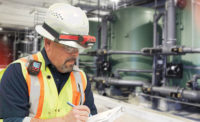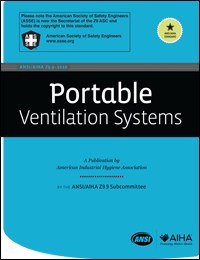
Safety professionals who use portable gas detectors are rapidly growing in number — they include fire crews, safety managers, law enforcement personnel, HVAC contractors, first responders, environmental consultants and contractors, industrial hygienists, confined space telecommunications, electrical and utility workers and many others.
While facing different occupational challenges, these workers all face a common occupational hazard — the invisible but potentially fatal threat posed by environments where toxic or flammable gases or VOCs (volatile organic compounds) are present.
Effective gas detection is a fundamental safety precaution. Let’s take a look at some of the key features, functionality and best-use practices of portable gas detection instrumentation.
Choosing a portable gas detector
•Is the unit easy to use?— Most portable gas detectors are designed for ease-of-use, with single-button operation. Premium models may offer such details as large backlit displays and oversized, heavy-duty buttons. These features help the user operate and view gas readings in foggy, dark or wet conditions.
Another ease-of-use feature is whether the unit is able to log standard data as well as event and calibration data that can be loaded onto a computer program in case the data needs to be retrieved. In addition, if any workers have a limited understanding of English, check to see if the portable offers multi-lingual display or voice-assisted operation.
The unit should also convey alarm annunciation in multisensory ways — audibly, visually and tactilely (through vibration). In this way, workers will be alerted to emergency alarms, quickly and without fail.
•Is the instrument reliable?— A powerful sampling pump in a gas detector not only ensures accurate readings of remote samplings, but longer unit life. Further, are the batteries rechargeable? Are the sensors themselves durable and resistant to poisons that may affect performance or shorten cell life?
Performance issues like these may be difficult to assess, but in some cases, sensors designed for longevity are also designed for easy replacement. If your crew, for example, monitors multiple gases, you may receive better value through the unique built-in sensor/cartridge design available today. When one sensor fails, the whole sensor set can be swapped out, ensuring a fresh set of sensors. Due to the economies of sensor manufacture, this multi-sensor cartridge design enables a multi-sensor exchange to be carried out at about the same cost as replacing a single sensor.
•Does the unit monitor all gases and chemicals that pose a threat?— Today’s generation of portable gas detectors are capable of monitoring multiple gases simultaneously — in many cases, up to four or five, including the most common hazards found in many unstable environments. Typically, these can be identified as CH4 (methane), CO (carbon monoxide), H2S (hydrogen sulfide) and O2 (oxygen gas). Sensors are also available for VOCs found in confined spaces and can detect paint thinners, rotting vegetation, chemical residue from arc welding or other work performed previously.
•Does the instrument require little maintenance?— Portable gas detectors today feature rugged, concussion-proof technology built into them. However, check to see if the unit is IP67 rated, which gives the user a high degree of protection against dust and water ingress, so that the unit will function under the most adverse conditions.
•Does the unit offer communications capabilities?— It is important to continuously monitor gases in confined spaces, as concentrations can change rapidly. In particularly dangerous confined spaces, it is desirable to use gas detectors that are linked by cabling for communication; these enable safety check messages to be shared between remote workers. This feature assures confined space workers that their colleagues are still conscious and not affected by toxic or flammable gases or oxygen diminution.
Using a portable gas detector
•Calibrate your instrument— The most common mistakes people make in using gas detection instrumentation are using incorrect calibration procedures or calibrating the unit when it’s not necessary — often a simple bump test or confidence check will do. Other mistakes include using the wrong calibration gas, not knowing how to calibrate a gas detector or read values on the unit, not paying attention to the expiration dates, using improper cabling and not following product specifications.
These problems can be rectified by onsite training. If your company has a mix of equipment, you may want to evaluate a certification-based program by some portables manufacturers. Such a program provides specialized training that can be customized to specific equipment, site application and attendees.
On the other hand, some calibration kits require little or no training on the operator’s part and can be carried out with one-button operation. The entire testing and calibration sequence can be done in two minutes or less, with a simple “pass” or “fail” notification displayed and more detailed results logged for later download.
•Test the atmosphere before entering a confined space— Are the testing devices you use operational and appropriate? All safety managers should follow a routine that goes something like this: Insert the probe through the vent of the confined space area (if possible), then open the entranceway and test more thoroughly from the outside. Test all levels and areas. If gases or vapors are detected, ventilate and retest.
•Routinely conduct tests upon entering the space (having completed pre-entry checks)— It’s important to remember that toxic or flammable substances may be disturbed due to work performed earlier, so a potential for hazards exists every time a confined space is entered. Unrecognized atmospheric hazards are the number one cause of fatalities in confined spaces. What’s more, changes in atmospheric conditions can occur at any time. Regretfully, complacency is all too common. It is necessary to continuously monitor for gas hazards and conduct testing before every new entry — for example, after lunch breaks.
•Inspect your equipment— Gas detectors should be inspected and tested regularly to ensure correct operation. Multi-gas monitors should be tested before each use and re-calibrated if necessary. Follow the manufacturer’s guidelines for verification/bump tests and calibration. Use only certified calibration gases and the correct/recommended calibration equipment.
•Use fully serviceable equipment— Any equipment defects should be reported to the project lead or supervisor. Quality equipment means longer battery and sensor life, protection against dust and water ingress, and availability of spare parts and service. No one should ever wear or use defective equipment.
•Have a calibration kit/bump test station at the entrance of the job site— A good bump test station will have a low flow rate, which enables more calibrations per cylinder and adds up to a lower cost of ownership.
Be prepared
With a little preparation, you can maximize the short- and long-term value of your company’s investment in portable gas detection instrumentation. You can track evidence of safety and compliance; protect people, equipment and environment; maintain worker productivity; and increase company profitability.

